A
Auto Express
Guest
Skoda scored an instant hit with the Yeti, so when it came to replace the crossover, it was a surprise to many that the name was dropped and replaced with Karoq. The reason for the change was to bring the mid-sized crossover into line with the larger Kodiaq, while the Karoq name has the same Inuit Eskimo roots as the Kodiaq's.
The Karoq's design is also heavily influenced by the Kodiaq. The shape of the lights front and rear are similar to the larger car, and Skoda's familiar grille shape is present and correct. However, remove these details, and the Karoq looks largely similar to the SEAT Ateca, although that should come as no surprise, as both cars are identical underneath.
The Ateca is just one of a number of strong contenders in the compact SUV class. Elsewhere, the Peugeot 3008 is one of our class favourites, while the Vauxhall Grandland X shares running gear with that model, too. The class founder, the Nissan Qashqai, recently had a facelift, while the Renault Kadjar is built on the same platform, but is very slightly larger inside. Then there's the Hyundai Tucson, Kia Sportage, Mazda CX-5, Ford Kuga, Toyota RAV4, Honda CR-V and VW Tiguan, all of which have their own strong points. But overall, the Karoq has a good mix of talents to place it at the front of the pack.
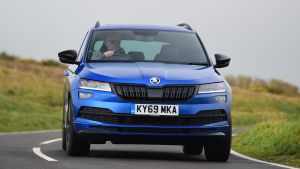
image
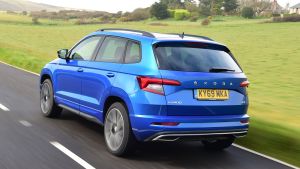
image
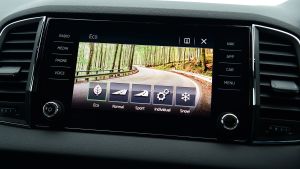
image

image
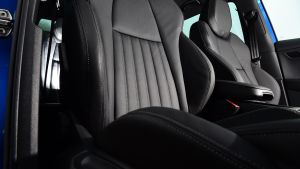
image
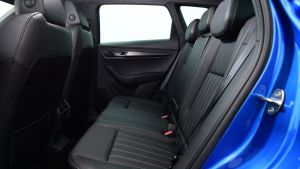
image

image
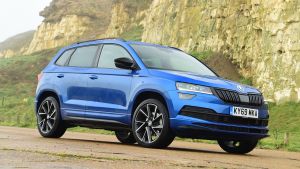
image
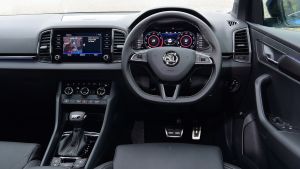
image
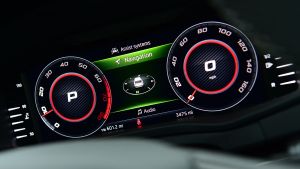
image
Engine choice in the Karoq range consists of 1.0, 1.5 TSI and 2.0-litre turbocharged petrols and 1.6 and 2.0 TDI diesels. The 1.0 TSI 116PS is a three-cylinder unit that is surprisingly capable of pulling this crossover around, courtesy of the Karoq's relatively lightweight build. The 1.5 TSI 150PS is the VW Group's latest four-cylinder petrol motor, so combines good power with decent efficiency helped in part by cylinder deactivation on light throttle loads. The 187bhp 2.0-litre petrol engine is reserved for the expensive if smart-looking Sportline variant, though.
Diesel power comes from the 1.6 TDI 116PS and the 2.0 TDI 150PS versions. The lower powered unit only comes as a two-wheel-drive variant, with a DSG auto gearbox and in SE L trim.
The 2.0 TDI 150PS is offered with both two- and four-wheel-drive transmissions across most trim levels. A six-speed manual gearbox is standard in most cases, while the seven-speed twin-clutch DSG auto is offered as an option.
The Karoq model range kicks off with SE trim, but this entry point to the range is still decently equipped. There are 17-inch alloys, a DAB radio, Bluetooth and dual-zone climate control, while SE Drive adds sat-nav and rear parking sensors for a premium of around £900 over SE. In the Karoq SE L you get 19-inch alloy wheels, heated front seats and upgraded Microsuede upholstery.
If you’re looking for a bit more luxury, the Karoq Edition brings a panoramic sunroof, an electrically-operated driver's seat with memory function, leather-trimmed seats and an electric tailgate. The Karoq Scout and Sportline versions add rugged 4x4 looks or a sportier appearance respectively, plus standard four-wheel drive on all Scout models and decent levels of kit across both trims.
Under the skin, the Skoda Karoq uses a tried-and-tested recipe, combining the VW Group’s MQB underpinnings (with MacPherson strut front suspension and a torsion beam rear axle on 2WD versions, while 4x4 cars have a multilink set-up) that also forms the basis of the Kodiaq and many other models in the Czech brand’s line-up, highlighting its versatility.
On the move, the Skoda feels sharper than the Peugeot 3008. The steering is nicely weighted and more responsive – and it’s more agile, with less roll when changing direction. This stems from the Karoq’s firmer suspension, but the downside is that you’ll feel more body and wheel movements than in the 3008, which smooths out poor surfaces nicely. However, the Karoq isn't as firm as the SEAT Ateca sister model.
The faster you go, the more the Karoq’s body control comes to the fore, though, giving plenty of security and confidence. The more energy you put through the springs and dampers, the more the ride quality calms down, but because these SUVs are likely to spend lots of time in town, the lumpier feeling from the Skoda’s suspension over broken surfaces just takes the edge off the car’s otherwise impressive refinement. However, it’s only marginally less supple than a 3008.
It's worth noting the ride takes a turn for the worse if you go for the Sportline model. Adding 19-inch alloys to what is a fairly compliant family SUV causes it to develop unwelcome jiggliness over uneven A and B roads, and causes some annoying harmonics to present themselves over concrete sections of motorway. There's no denying the Sportline model looks the part, though, and it's also fair to say the Karoq is not alone in having its ride adversely affected by larger alloys.
Engines
Of the two petrol engines, the larger 1.5 TSI comes out as our clear favourite, although the smaller 1.0-litre three-cylinder engine performs pretty well, too. The entry-level TSI unit makes a respectable 113bhp, and while it will accelerate the Karoq from 0-62mph in 10.6 seconds, it feels a little strained at higher speeds or when fully laden. It means that when accelerating hard, you can feel and hear the work the little engine is having to put in, as the noise becomes somewhat intrusive and there’s a small amount of vibration present through the pedals.

image

image

image

image

image

image

image

image

image

image
The larger 1.5 TSI has a broader power band, and with 148bhp it’s a stronger performer and more refined – 0 to 62mph arrives in 8.9 seconds (or 9.0 seconds with the DSG twin-clutch auto option), and you don’t have to work the engine quite so hard.
The smallest 1.6-litre TDI turbodiesel makes the same 113bhp as the entry-level petrol, but has more torque, so it doesn’t feel quite as strained when you need a bit of grunt, although it too can be noisy when stretched. It manages the 0-62mph sprint in 11.2 seconds.
The 2.0-litre TDI has 148bhp, and knocks off the benchmark sprint in 9.0 seconds, as well as offering a lot more punch for overtaking. This will help if you’re intending to tow as well.
Opt for the Sportline model and as well as the 148bhp petrol and diesel engines, you can also have 2.0-litre 187bhp petrol unit. Sportline is the only trim with which you can get this engine – the most powerful in the Karoq range – and while a circa £34,000 list price means this configuration is by no means cheap, a 7.3-second 0-62mph time means it certainly shifts.
Aside from the relative practicality, one of the Karoq’s great attractions is the combination of fashionable SUV style with manageable running costs. Apart from a small fuel economy penalty, these cars shouldn’t cost more to run than a comparable hatchback.
The Karoq’s petrol engines look attractive from a cost point of view too, as they’re pretty efficient and cheaper to buy than the diesels you might typically associate with the SUV genre.
The Karoq’s engines aren’t class-leading for economy, but they’re still among the most efficient in the sector. The 1.0 TSI can return up to a claimed 45.6mpg combined while emitting 141g/km of CO2. The larger 1.5 TSI’s official maximum figures are 44.8mpg (44.1mpg with the DSG auto), with CO2 emissions from 143g/km.

image

image

image

image

image

image

image

image

image

image
If you really do want to eke the best mileage out of every gallon, the manual 2.0-litre diesel is the sensible choice. It returns up to 52.3mpg with CO2 emissions from 142g/km. The 2.0-litre 4x4 diesels come with auto transmission and aren’t quite as efficient, offering a best of 42.8mpg and 172g/km of CO2.
Insurance groups
You won’t pay too much for insurance with any of the Karoq models, but the lower spec versions are obviously cheaper, with the smaller petrol and diesel engines attracting a Group 10 rating. The 1.5 petrol and 2.0 diesel are Group 14 and 16 respectively, and premiums across the range should be cheaper than the Peugeot 3008 which is Group 11 to 24, helped by strong safety tech.
Depreciation
Skoda is known for solid residual values, so we'd expect the Karoq to fare better than some of its Korean or French rivals. Data suggests the Karoq should retain an average of 46% of its value over three years and 36,000 miles.
While the Yeti design was arguably more characterful than the Karoq, this model has a broader range of talents. It’s a mature design, and while it lacks any flashes of stylistic flair it does have a solid, almost premium appeal.
At a glance, there’s not much to separate it from the bigger seven-seat Kodiaq, with a very similar grille and headlamp design, the same ridge up the centre of the bonnet, and a similar side profile set with chunky wheelarches. The rear lights are the biggest difference at the rear, and despite variations in details such as intake shapes in the lower bumpers, even car enthusiasts could be forgiven for a little difficulty in telling the two models apart. Park them side-by-side, and the Kodiaq’s extra length stands out, but it’s wider and taller too.

image

image

image

image

image

image

image

image

image

image
There’s only one five-door body variant for the Karoq, as with the Kodiaq, and while the Karoq only offers five seats it can be specified with the same VarioFlex adjustable rear bench as the Kodiaq that allows you to alter the amount of passenger legroom or boot space depending on your needs.
Inside, the Karoq cabin design is identical to that of the bigger Kodiaq, which means it’s conservative with no flashy or fashionable design highlights. But it’s also incredibly functional, with great ergonomics, plenty of space and a sense of quality. It feels well built, while it’s also stacked with tech features.
Sat-nav, stereo and infotainment
Built-in sat-nav isn’t as big a deal as it used to be in this class, especially when all Karoq models get a good level of smartphone connectivity, offering navigation through your phone on the standard eight-inch screen.
The level of connection is improved with the 9.2-inch optional Columbus system, which is standard on Edition models and above and offered as an option on SE L. While this adds gesture control, the standard Amundsen system gets the same WiFi hotspot, voice control and a one-year subscription to Skoda’s online services.

image

image

image

image

image

image

image

image

image

image
You can add features such as wireless phone charging for £300 to improve the technology on offer with the Karoq, but they’re not really necessary because the core of the system is what makes the Skoda’s unit so capable.
A bright screen, sharp graphics and simple menu layout mean it’s easy to use. The glossy screen picks up fingerprints, but with Apple CarPlay and Android Auto, plus other services with a valid data connection, it’s advanced and more responsive than the Peugeot 3008’s infotainment.
On the road, a hushed cabin that’s marred only a little by wind noise around the door pillars at higher speeds and a little too much engine noise under hard acceleration in entry level cars goes hand-in-hand with a supple ride to make the Karoq a comfortable SUV. Throw in the supportive seats, roomy cabin, well laid out controls and high quality fit and finish, not to mention plenty of gadgets and toys on top versions, and it’s an impressive effort.
The large interior with its voluminous boot is well suited to family use, and there are a range of options you can add that will make life a little easier. Cabin features include a large Jumbo Box for gadgets and drinks that sits between the front seats, and there are plenty of storage spaces dotted around, plus foldable tables in the backs of both front seats.
Things like a space-saver spare, rough road package with engine and chassis guards, a reversing camera and adaptive cruise control are all either standard or available optionally to improve how easy the Karoq is to live with.
Size
The Karoq is noticeably bigger than its predecessor, the Yeti, and measures 4,382mm long, 1,841mm wide and 1,603mm tall. That compares with the 4,447mm length of the Peugeot 3008, or 4,394mm of the Nissan Qashqai, so it’s pretty much on par with its rivals.

image

image

image

image

image

image

image

image

image

image
Leg room, head room & passenger space
There’s good leg and headroom in any of the seats in the Skoda Karoq – in fact the rear-seat passengers do slightly better for headroom than those in back of the larger Kodiaq. Taller rear seat passengers may find their knees brushing on the seat backs though.
Boot
Depending on spec the Karoq’s tailgate raises electrically, and there’s a ‘virtual pedal’ that allows you to open it with the waggle of a foot under the rear bumper if your hands are full. Once it’s open you’re greeted by an impressive load area, that’s practically shaped and roomy. In standard form it will swallow 521 litres with the rear seats in place, or a huge 1,810 litres when they’re folded. Opt for the VarioFlex rear seats and you can adjust the ‘seats up’ figure from between 479 to 588 litres – although more luggage space means less legroom.
As it’s based on the VW Group MQB platform the Skoda Karoq shares its underpinnings with a huge number of cars from the Audi, SEAT, Skoda and VW stables. The list includes names from the Audi A3 to the VW Touran, with almost two dozen different models either in production or in the pipeline.
All of which means that the Karoq’s engineering and technology is already very well-proven, and that bodes very well for the model’s likely reliability. As a marque, Skoda regularly puts in an extremely good performance in our own Driver Power survey and, in 2020, the Czech car maker finished 5th out of 30 manufacturers. The Karoq itself placed a creditable 15th out of 100 in the owner satisfaction poll.

image

image

image

image

image

image

image

image

image

image
Euro NCAP has already performed independent crash tests on the Karoq, awarding a full five-star rating and a great score for adult occupant safety at 93%.
There’s a full range of the latest safety measures available as you would expect, and most of it’s fitted as standard to the top-spec Karoq Edition. It comes with traffic sign recognition, lane assistance, cross traffic alert and blind spot monitoring, as well as autonomous braking that’s standard across the range.
Warranty
A three-year/60,000-mile warranty is standard, which is standard for the industry. However, rivals such as Toyota, Renault, Hyundai and Kia offer more extensive coverage.
Servicing
The Skoda Karoq requires annual servicing unless you do mainly long-distance motorway driving, in which case the intervals can be extended – onboard computers tell you by how much while the brand’s servicing packs are relatively affordable when bought up front.
For an alternative review of the latest Skoda Karoq SUV visit our sister site carbuyer.co.uk
Continue reading...
The Karoq's design is also heavily influenced by the Kodiaq. The shape of the lights front and rear are similar to the larger car, and Skoda's familiar grille shape is present and correct. However, remove these details, and the Karoq looks largely similar to the SEAT Ateca, although that should come as no surprise, as both cars are identical underneath.
The Ateca is just one of a number of strong contenders in the compact SUV class. Elsewhere, the Peugeot 3008 is one of our class favourites, while the Vauxhall Grandland X shares running gear with that model, too. The class founder, the Nissan Qashqai, recently had a facelift, while the Renault Kadjar is built on the same platform, but is very slightly larger inside. Then there's the Hyundai Tucson, Kia Sportage, Mazda CX-5, Ford Kuga, Toyota RAV4, Honda CR-V and VW Tiguan, all of which have their own strong points. But overall, the Karoq has a good mix of talents to place it at the front of the pack.

image

image

image

image

image

image

image

image

image

image
Engine choice in the Karoq range consists of 1.0, 1.5 TSI and 2.0-litre turbocharged petrols and 1.6 and 2.0 TDI diesels. The 1.0 TSI 116PS is a three-cylinder unit that is surprisingly capable of pulling this crossover around, courtesy of the Karoq's relatively lightweight build. The 1.5 TSI 150PS is the VW Group's latest four-cylinder petrol motor, so combines good power with decent efficiency helped in part by cylinder deactivation on light throttle loads. The 187bhp 2.0-litre petrol engine is reserved for the expensive if smart-looking Sportline variant, though.
Diesel power comes from the 1.6 TDI 116PS and the 2.0 TDI 150PS versions. The lower powered unit only comes as a two-wheel-drive variant, with a DSG auto gearbox and in SE L trim.
The 2.0 TDI 150PS is offered with both two- and four-wheel-drive transmissions across most trim levels. A six-speed manual gearbox is standard in most cases, while the seven-speed twin-clutch DSG auto is offered as an option.
The Karoq model range kicks off with SE trim, but this entry point to the range is still decently equipped. There are 17-inch alloys, a DAB radio, Bluetooth and dual-zone climate control, while SE Drive adds sat-nav and rear parking sensors for a premium of around £900 over SE. In the Karoq SE L you get 19-inch alloy wheels, heated front seats and upgraded Microsuede upholstery.
If you’re looking for a bit more luxury, the Karoq Edition brings a panoramic sunroof, an electrically-operated driver's seat with memory function, leather-trimmed seats and an electric tailgate. The Karoq Scout and Sportline versions add rugged 4x4 looks or a sportier appearance respectively, plus standard four-wheel drive on all Scout models and decent levels of kit across both trims.
Under the skin, the Skoda Karoq uses a tried-and-tested recipe, combining the VW Group’s MQB underpinnings (with MacPherson strut front suspension and a torsion beam rear axle on 2WD versions, while 4x4 cars have a multilink set-up) that also forms the basis of the Kodiaq and many other models in the Czech brand’s line-up, highlighting its versatility.
On the move, the Skoda feels sharper than the Peugeot 3008. The steering is nicely weighted and more responsive – and it’s more agile, with less roll when changing direction. This stems from the Karoq’s firmer suspension, but the downside is that you’ll feel more body and wheel movements than in the 3008, which smooths out poor surfaces nicely. However, the Karoq isn't as firm as the SEAT Ateca sister model.
The faster you go, the more the Karoq’s body control comes to the fore, though, giving plenty of security and confidence. The more energy you put through the springs and dampers, the more the ride quality calms down, but because these SUVs are likely to spend lots of time in town, the lumpier feeling from the Skoda’s suspension over broken surfaces just takes the edge off the car’s otherwise impressive refinement. However, it’s only marginally less supple than a 3008.
It's worth noting the ride takes a turn for the worse if you go for the Sportline model. Adding 19-inch alloys to what is a fairly compliant family SUV causes it to develop unwelcome jiggliness over uneven A and B roads, and causes some annoying harmonics to present themselves over concrete sections of motorway. There's no denying the Sportline model looks the part, though, and it's also fair to say the Karoq is not alone in having its ride adversely affected by larger alloys.
Engines
Of the two petrol engines, the larger 1.5 TSI comes out as our clear favourite, although the smaller 1.0-litre three-cylinder engine performs pretty well, too. The entry-level TSI unit makes a respectable 113bhp, and while it will accelerate the Karoq from 0-62mph in 10.6 seconds, it feels a little strained at higher speeds or when fully laden. It means that when accelerating hard, you can feel and hear the work the little engine is having to put in, as the noise becomes somewhat intrusive and there’s a small amount of vibration present through the pedals.

image

image

image

image

image

image

image

image

image

image
The larger 1.5 TSI has a broader power band, and with 148bhp it’s a stronger performer and more refined – 0 to 62mph arrives in 8.9 seconds (or 9.0 seconds with the DSG twin-clutch auto option), and you don’t have to work the engine quite so hard.
The smallest 1.6-litre TDI turbodiesel makes the same 113bhp as the entry-level petrol, but has more torque, so it doesn’t feel quite as strained when you need a bit of grunt, although it too can be noisy when stretched. It manages the 0-62mph sprint in 11.2 seconds.
The 2.0-litre TDI has 148bhp, and knocks off the benchmark sprint in 9.0 seconds, as well as offering a lot more punch for overtaking. This will help if you’re intending to tow as well.
Opt for the Sportline model and as well as the 148bhp petrol and diesel engines, you can also have 2.0-litre 187bhp petrol unit. Sportline is the only trim with which you can get this engine – the most powerful in the Karoq range – and while a circa £34,000 list price means this configuration is by no means cheap, a 7.3-second 0-62mph time means it certainly shifts.
Aside from the relative practicality, one of the Karoq’s great attractions is the combination of fashionable SUV style with manageable running costs. Apart from a small fuel economy penalty, these cars shouldn’t cost more to run than a comparable hatchback.
The Karoq’s petrol engines look attractive from a cost point of view too, as they’re pretty efficient and cheaper to buy than the diesels you might typically associate with the SUV genre.
The Karoq’s engines aren’t class-leading for economy, but they’re still among the most efficient in the sector. The 1.0 TSI can return up to a claimed 45.6mpg combined while emitting 141g/km of CO2. The larger 1.5 TSI’s official maximum figures are 44.8mpg (44.1mpg with the DSG auto), with CO2 emissions from 143g/km.

image

image

image

image

image

image

image

image

image

image
If you really do want to eke the best mileage out of every gallon, the manual 2.0-litre diesel is the sensible choice. It returns up to 52.3mpg with CO2 emissions from 142g/km. The 2.0-litre 4x4 diesels come with auto transmission and aren’t quite as efficient, offering a best of 42.8mpg and 172g/km of CO2.
Insurance groups
You won’t pay too much for insurance with any of the Karoq models, but the lower spec versions are obviously cheaper, with the smaller petrol and diesel engines attracting a Group 10 rating. The 1.5 petrol and 2.0 diesel are Group 14 and 16 respectively, and premiums across the range should be cheaper than the Peugeot 3008 which is Group 11 to 24, helped by strong safety tech.
Depreciation
Skoda is known for solid residual values, so we'd expect the Karoq to fare better than some of its Korean or French rivals. Data suggests the Karoq should retain an average of 46% of its value over three years and 36,000 miles.
While the Yeti design was arguably more characterful than the Karoq, this model has a broader range of talents. It’s a mature design, and while it lacks any flashes of stylistic flair it does have a solid, almost premium appeal.
At a glance, there’s not much to separate it from the bigger seven-seat Kodiaq, with a very similar grille and headlamp design, the same ridge up the centre of the bonnet, and a similar side profile set with chunky wheelarches. The rear lights are the biggest difference at the rear, and despite variations in details such as intake shapes in the lower bumpers, even car enthusiasts could be forgiven for a little difficulty in telling the two models apart. Park them side-by-side, and the Kodiaq’s extra length stands out, but it’s wider and taller too.

image

image

image

image

image

image

image

image

image

image
There’s only one five-door body variant for the Karoq, as with the Kodiaq, and while the Karoq only offers five seats it can be specified with the same VarioFlex adjustable rear bench as the Kodiaq that allows you to alter the amount of passenger legroom or boot space depending on your needs.
Inside, the Karoq cabin design is identical to that of the bigger Kodiaq, which means it’s conservative with no flashy or fashionable design highlights. But it’s also incredibly functional, with great ergonomics, plenty of space and a sense of quality. It feels well built, while it’s also stacked with tech features.
Sat-nav, stereo and infotainment
Built-in sat-nav isn’t as big a deal as it used to be in this class, especially when all Karoq models get a good level of smartphone connectivity, offering navigation through your phone on the standard eight-inch screen.
The level of connection is improved with the 9.2-inch optional Columbus system, which is standard on Edition models and above and offered as an option on SE L. While this adds gesture control, the standard Amundsen system gets the same WiFi hotspot, voice control and a one-year subscription to Skoda’s online services.

image

image

image

image

image

image

image

image

image

image
You can add features such as wireless phone charging for £300 to improve the technology on offer with the Karoq, but they’re not really necessary because the core of the system is what makes the Skoda’s unit so capable.
A bright screen, sharp graphics and simple menu layout mean it’s easy to use. The glossy screen picks up fingerprints, but with Apple CarPlay and Android Auto, plus other services with a valid data connection, it’s advanced and more responsive than the Peugeot 3008’s infotainment.
On the road, a hushed cabin that’s marred only a little by wind noise around the door pillars at higher speeds and a little too much engine noise under hard acceleration in entry level cars goes hand-in-hand with a supple ride to make the Karoq a comfortable SUV. Throw in the supportive seats, roomy cabin, well laid out controls and high quality fit and finish, not to mention plenty of gadgets and toys on top versions, and it’s an impressive effort.
The large interior with its voluminous boot is well suited to family use, and there are a range of options you can add that will make life a little easier. Cabin features include a large Jumbo Box for gadgets and drinks that sits between the front seats, and there are plenty of storage spaces dotted around, plus foldable tables in the backs of both front seats.
Things like a space-saver spare, rough road package with engine and chassis guards, a reversing camera and adaptive cruise control are all either standard or available optionally to improve how easy the Karoq is to live with.
Size
The Karoq is noticeably bigger than its predecessor, the Yeti, and measures 4,382mm long, 1,841mm wide and 1,603mm tall. That compares with the 4,447mm length of the Peugeot 3008, or 4,394mm of the Nissan Qashqai, so it’s pretty much on par with its rivals.

image

image

image

image

image

image

image

image

image

image
Leg room, head room & passenger space
There’s good leg and headroom in any of the seats in the Skoda Karoq – in fact the rear-seat passengers do slightly better for headroom than those in back of the larger Kodiaq. Taller rear seat passengers may find their knees brushing on the seat backs though.
Boot
Depending on spec the Karoq’s tailgate raises electrically, and there’s a ‘virtual pedal’ that allows you to open it with the waggle of a foot under the rear bumper if your hands are full. Once it’s open you’re greeted by an impressive load area, that’s practically shaped and roomy. In standard form it will swallow 521 litres with the rear seats in place, or a huge 1,810 litres when they’re folded. Opt for the VarioFlex rear seats and you can adjust the ‘seats up’ figure from between 479 to 588 litres – although more luggage space means less legroom.
As it’s based on the VW Group MQB platform the Skoda Karoq shares its underpinnings with a huge number of cars from the Audi, SEAT, Skoda and VW stables. The list includes names from the Audi A3 to the VW Touran, with almost two dozen different models either in production or in the pipeline.
All of which means that the Karoq’s engineering and technology is already very well-proven, and that bodes very well for the model’s likely reliability. As a marque, Skoda regularly puts in an extremely good performance in our own Driver Power survey and, in 2020, the Czech car maker finished 5th out of 30 manufacturers. The Karoq itself placed a creditable 15th out of 100 in the owner satisfaction poll.

image

image

image

image

image

image

image

image

image

image
Euro NCAP has already performed independent crash tests on the Karoq, awarding a full five-star rating and a great score for adult occupant safety at 93%.
There’s a full range of the latest safety measures available as you would expect, and most of it’s fitted as standard to the top-spec Karoq Edition. It comes with traffic sign recognition, lane assistance, cross traffic alert and blind spot monitoring, as well as autonomous braking that’s standard across the range.
Warranty
A three-year/60,000-mile warranty is standard, which is standard for the industry. However, rivals such as Toyota, Renault, Hyundai and Kia offer more extensive coverage.
Servicing
The Skoda Karoq requires annual servicing unless you do mainly long-distance motorway driving, in which case the intervals can be extended – onboard computers tell you by how much while the brand’s servicing packs are relatively affordable when bought up front.
For an alternative review of the latest Skoda Karoq SUV visit our sister site carbuyer.co.uk
Continue reading...
